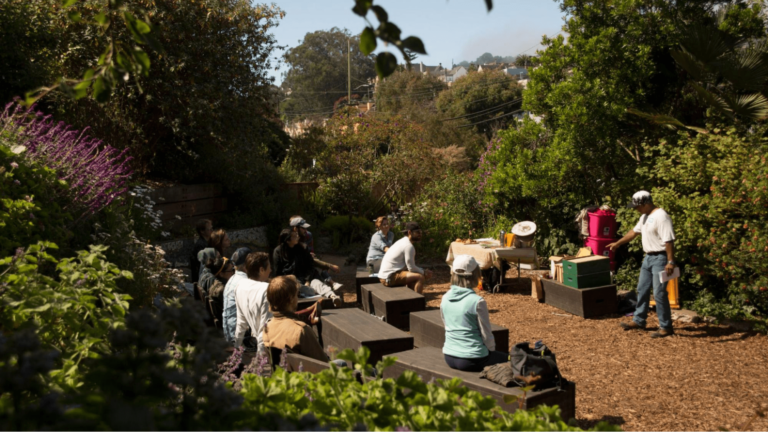At Eventbrite, sustainability is part of our ethos. That’s why we’re so proud to have achieved 100% carbon neutrality. We love sharing that passion with our sprawling global community of sustainable event creators who are just as passionate about the environment as we are.
But, let’s face it, with a never-ending to-do list and a budget that seems to shrink by the minute, adding sustainable event planning to the mix might feel overwhelming.
Knowing how to plan a sustainable event is not just a niche skill or a trend — it’s essential in today’s world. Green events are not just responsible choices, but rewarding ones. They’re opportunity to make a positive impact, inspire others, and showcase your commitment to a healthier planet.
In this guide, we’ll explain what sustainable event management is all about, explain how to make an event more sustainable and share pro tips that’ll help you reduce your carbon footprint, no matter what type of event you’re planning.
So, without further ado, let’s dive in — the planet isn’t going to save itself, is it?
11 Green Hacks for Eco-Friendly Events
Develop unique sustainability goals
Choose a venue that’s ISO-compliant
Join networking events to meet sustainable vendors
Give chemical toilets the flush

Why are sustainable events important?
The importance of sustainability in events has become a pressing issue in recent years, and this trend will only continue.
The hard truth is that the events industry generally has some negative impacts on the environment.
The average three-day, 1,000-person event needs 530 metric tonnes of oil to feed its energy consumption — and waste management is an even bigger issue. A typical three-day event can generate up to 5,670kg of waste. That represents 1,890kg of waste per day, and almost two-thirds of that waste ends up going directly to landfill.
None of this paints the events industry in a great light — and the fact of the matter is that your event attendees want to see more eco-friendly events.
According to researchers at SmartestEnergy, 80% of consumers prefer to buy from sustainable companies. Meanwhile, 81% of festival-goers say they expect the festivals they attend to offset their negative environmental impacts.
Another survey by PwC found customers are willing to pay more for those sustainable options, too — with 80% of people saying they’re happy to pay up to 5% more for eco-friendly products and services.
Translation: More and more people expect large-scale events to be sustainably managed. As an event creator, it falls on you to execute sustainable event ideas that minimise your carbon impact and improve everyone’s event experience simultaneously.

What is sustainable event management?
To put it simply, sustainable event management is the process of making individual choices that reduce the environmental impact of your event.
As a creator, it’s your responsibility to do what you can to lower the carbon footprint of your event as much as possible. Making your event sustainable starts at the planning stage and impacts all of your decisions, including the contractors, sponsors, and suppliers you work with.
Sustainable event management covers a range of areas. But the key strands you’ll want to focus on to boost your event’s green credentials include:
- Minimising waste and litter
- Prioritising reusability and recycling
- Promoting sustainable transport options
- Minimising community disruption
- Assessing wildlife and nature risks
- Managing carbon emissions
With the right resources and support in place, these are hurdles you can tackle on your own. But if you’re running an entire business and have a lot of plates spinning, you might want to consider hiring an event professional or consultant that specialises in sustainability.
Sustainable event management as a niche is a rapidly rising, up-and-coming career option. Higher education institutions across the UK (like Falmouth University) are starting to offer degree programmes that offer intensive, foundational training in sustainability events — so it could be worth consulting a specialist (or becoming one yourself!).

How to make events more sustainable
If you’re ready to start creating sustainable experiences for your event attendees, the good news is the opportunities are endless.
The key is understanding which sustainability initiatives organically slot in with the type of events you’re running. To help you go green and start axing your CO2 emissions, here are 11 inspirational pro tips.
1. Develop unique sustainability goals
Your first step towards creating greener events is to develop actionable sustainability goals unique to your event.
Start by developing an estimate of your event’s carbon and environmental impact.
For example, do you rely on single-use plastic products? Do your event attendees use public transport, or are they all driving separately to your events? Does your catering team end up with lots of leftover food?
If you need help getting started, the non-profit group myclimate.org has a free calculator that can help you work out your event’s carbon impact.
Once you’ve worked out how your event will impact the environment, you can start coming up with actionable goals you can work towards. For example, maybe you want to ban single-use plastics at your next event, aim to reduce your water usage by 20%, or make sure your catering options are 50% vegan.

2. Keep it local
When it comes to sourcing what you need for your event, try to do so as locally as possible to cut down on transport. This also has the added bonus of supporting the local community.
Think about what’s in season and readily available — it’s not green to ship in strawberries from South Africa so that you can have strawberries and cream in December!
Need a little bit of inspiration?
Check out Spring Farm’s Farm to Table Supper Club. By using local produce and ingredients sourced directly from a working farm, they’re able to slash food miles, support other local growers, and create unique and sustainable dining experiences for guests from all walks of life.
Create a professional event listing that sells more tickets

3. Choose a venue that’s ISO-compliant
The easiest way to create a green experience is to select sustainable event venues where everything will be taken care of for you.
To help ensure the venues you’re looking at walk the walk, limit your search to venues with an international sustainability certification like ISO 20121.
Introduced in 2012 by the International Organization for Standardization, ISO 20121 is a voluntary set of standards that sustainable venues and event planners adopt to showcase the eco-friendliness of their events
Measures in these standards range from using tap water instead of single-use plastic bottles to encouraging guests to use public transport. If you’re wondering what an ISO-compliant venue looks like, Manchester Central or ACC Liverpool are great examples.
A sustainable event venue can help you save resources like water and power, divert waste away from landfills, offer guests sustainably produced organic food, and offset all of your event’s carbon emissions.
To help your guests feel connected with the environment, you might also consider a venue like Sheepdrove, located on an organic farm in Berkshire.

4. Join networking events to meet sustainable vendors
To run a truly green event, you need to collaborate with sustainable event suppliers.
By choosing suppliers who align with your ethics, you can be sure they’ll do what they can to make your event environmentally friendly. Creating a list of requirements when choosing your suppliers is a good idea.
That way, you can set your own demands and go with suppliers that meet them. For instance, you might want all of your event decorations and props to be reusable — so find a supplier who can make that happen.
If you’re looking for a way to meet new green suppliers, Eventbrite is a great place to start. You’ll find a range of virtual events designed to connect sustainable business owners. There are also plenty of hybrid events, local markets, sustainability trade shows, and other types of events on sustainability where you can meet area vendors who share your values.
Not sure where to start? The Sustainable Events Show in London is a prime example.
The one-day show brings together environmentally friendly event venues, event services suppliers, and event technology companies that practise sustainability — and the event itself is carbon-neutral.
5. Create a green catering plan
Food is a major driver of climate change, so catering is key to green event planning. Reducing the amount of meat on offer and having more plant-based options can help to make your event more sustainable. Over-catering is common at many events, resulting in unnecessary waste.
“Food into landfill is a major cause of landfill methane emissions,” explains Meegan Jones, author of Sustainable Event Management: A Practical Guide.
“Food waste at events also contributes to startling global food waste statistics, estimated at 1/3 of all food produced being lost or wasted.”
To cut down on food wastage, Jones recommends accurately estimating the amount of food required for the number of attendees, the event type, and the timing of activities or breaks, and asking about dietary requirements in advance (which you can do on Eventbrite by creating an RSVP website with specific fields).
You should also ensure any unconsumed perishable food has been handled correctly so you can later donate it to food salvage programmes.

6. Send digital invitations
Given deforestation’s impact on climate change, you might want to avoid paper invites.
Rather than sending out invites and info packs, cut down on tonnes of paper waste and postage costs by using a digital alternative to paper. That’s where event platforms can offer a helping hand.
For example, with Eventbrite you can create an event page featuring full joining instructions for your attendees and send email invitations from your Eventbrite account.
Thanks to our wide range of integrations, you can promote and sell tickets directly on Facebook, embed a sales page directly on your own website, and maximise your event’s visibility via email and social media without using any paper signage.
With a suite of customisation tools, your digital invitation can look sleek and 100% on-brand — while Eventbrite marketing tools let you send up to 10,000 emails per day with no contact limits. Plus, you can view who’s opened your email invitation or unsubscribed from your mailing list so you can make data-driven decisions.
Meanwhile, attendees can download the Eventbrite app and receive digital tickets straight to their mobiles. Simply scan the QR code to easily check in attendees using the Eventbrite Organiser App.
7. Upcycle and recycle
When choosing materials for your event, try to incorporate recycled and upcycled elements where possible. Single-use items can produce a vast amount of waste and damage the planet. Instead, do what you can to source things that can be given a second life.
Strategies could include asking attendees to return their lanyards or badge covers after an event so they can be used again, or using whiteboards or chalkboards instead of paper signs that are more difficult to reuse.
Of course, there’ll be some materials that can’t be used again. In that case, recycle suitable materials, like plastic, cardboard, and paper. Encourage your attendees to recycle at your event, too, by making it clear where the recycling stations are and what they’re for.

8. Find green transport options
Excess carbon emissions produced by hundreds of single-occupant car journeys can have a harmful impact on the planet, so encourage attendees to find greener alternatives.
Many train operators are willing to offer discounted tickets for event delegates. Check with your venue or city convention bureau if they already have an agreement in place.
It won’t be possible for everybody to travel by train, so as an alternative, promote a car-sharing service such as liftshare.com to your attendees. Guests can use the site to either advertise their planned journey and look for others to share the ride or simply ask for a lift. Either way, you’ll be helping to cut down on emissions from people attending your event.
9. Give chemical toilets the flush
Chemical toilets aren’t just unpleasant — they’re also environmentally unfriendly. If you need outdoor facilities at your event, consider some of the newer, greener toilet options instead.
There are a range of chemical-free portable toilet options, including dry separation toilets, compost toilets, and combustion toilets.
To see how you can create a greener event using chemical-free toilets, draw inspiration from event creator Duncan Disorderly & The Scallywags. For last year’s annual Scallywag Party, they used composting loos to save a vast amount of water — cutting chemicals in the process.
The use of sawdust helps to eliminate smells, and once the waste has been composted, it can be spread on fields to feed the land. Don’t forget to include some recycled toilet paper!

10. Use renewable energy
If your event requires sound and staging, consider ways to save energy, like using solar power.
The Croissant Neuf Summer Party, for example, uses on-site solar to power the stages and lights, and the LED lighting system in the event’s Big Top uses less power than the average household television.
You could have some fun with your renewable energy supplies by asking your attendees to get involved.
You could even use coffee bikes and charger stations — pedalling can power a number of installations. Or you could use a dance floor or walkway to create kinetic energy. By asking attendees to generate power, you can entertain and educate at the same time.
11. Purchase carbon credits
Another great way to make your event carbon-neutral is by purchasing carbon credits.
A carbon credit is a token representing your event’s carbon impact. It caps your pollution and waste levels to a certain amount — and if you don’t end up using all of your credits, you can sell them back onto the market. This demonstrates to guests that you’re committed to capping your carbon footprint, and there’s a monetary incentive for using less than you’ve paid for.
Best of all, the carbon credits you purchase are used to directly finance sustainability projects across the globe.
There are a few different types of carbon credits, and you can learn more about them and purchase them on a number of carbon credit marketplaces like EcoTree, South Pole, and The Gold Standard Foundation.

Green event planning doesn’t have to be a challenge
Following a plan can take some of the hassle and cost out of planning a green event. Now that you know how to ensure event sustainability, Eventbrite can help you put your plan into action.
Sticking to a plan can strip away some of the fuss and expense involved in planning a green event. Now that you’re armed with the know-how to guarantee event sustainability, Eventbrite is here to help you transform that plan from a mere daydream into reality.
Attendees can download the Eventbrite app and receive digital tickets straight to their mobiles — simply scan the QR code to check them in using the Eventbrite Organiser App. Plus, we’ll help you optimise your event promotion through targeted online ads and by listing your event on the world’s largest events marketplace.






